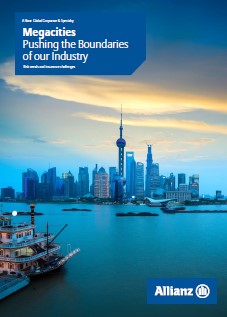Allianz: Megacities
November 10 2016
A recent Allianz publication: The megacity state: The world’s biggest cities shaping our future received widespread recognition. The document gives an insight into how human livelihood will evolve over the next 15 years and touches upon the challenges in risk and insurance, which society will face. In accordance with the United Nations (UN), Allianz defines megacities as urban areas exceeding 10 million inhabitants and describes them as highly interconnected, dynamic and vibrant centers, which will over time contribute higher income and living standards for their citizens.
The growth number for megacities is impressive. A 2006 UN working paper documented that there were only two megacities in 1950, Tokyo and New York City (NYC). The number increased marginally in the following quarter century to three in 1975, Tokyo, NYC and Mexico City. In contrast, the next 25 years saw a dramatic growth to 18 megacities in 2000. Since then, the digital age has reinforced the pull factor exerted by the megacity and makes it increasingly difficult for demographic experts and governments to extrapolate, forecast and steer the growth. In this respect, the above mentioned 2006 UN working paper predicted 22 megacities in 2015, while in reality the last year recorded 29 megacities – a good 30% above the UN forecast.
Megacities in their enormous size accumulate impressive physical, human and intellectual resources, they increase economies of scale and lower production costs.
-
SIRC: Distinct reinsurance solutions are emerging to address emerging capital strategies: Guy Carpenter
- November 4
As insurers improve their understanding of the risks they are carrying and capital productivity, structured reinsurance and alternative sources of reinsurance capital are being increasingly considered, Guy Carpenter’s Justin Ward says.
-
QBE’s Hammond on transformation and growth
- July 2
The Asia chief executive discusses Covid-19, going digital and restructuring.
-
Swiss Re: Nat cats and man-made disasters in 2018
- April 10
Climate change, increased urbanisation and a growing concentration of assets were on the risk agenda for 2018.
-
Willis Towers Watson: 2019 Asia Market Report
- March 19
Economic uncertainty, more complex risks and tighter underwriting are all influencing Asia's markets.
-
QBE | Elevating customer experience, humanising claims: QBE Asia’s ‘Solutions in a Box’
Vastly improving turnaround times and personalising service delivery, QBE Asia’s award-winning, end-to-end bundled claims solutions is a game-changer for the insurance industry.
-
Beazley | What does cyber protection look like from day 1 to day 600 and beyond?
Cybersecurity is no longer just an IT concern, but a governance issue that belongs on the boardroom agenda.
-
Sedgwick | Preparing for the next storm
Insurance industry needs to recalibrate, invest in innovation and strengthen systems, talent and data practices.
-
Peak Re | From climate modelling to market opportunity: Forging a new clarity on Southeast Asia’s climate risk
Southeast Asia's protection gap: a crisis of clarity, not just capital

